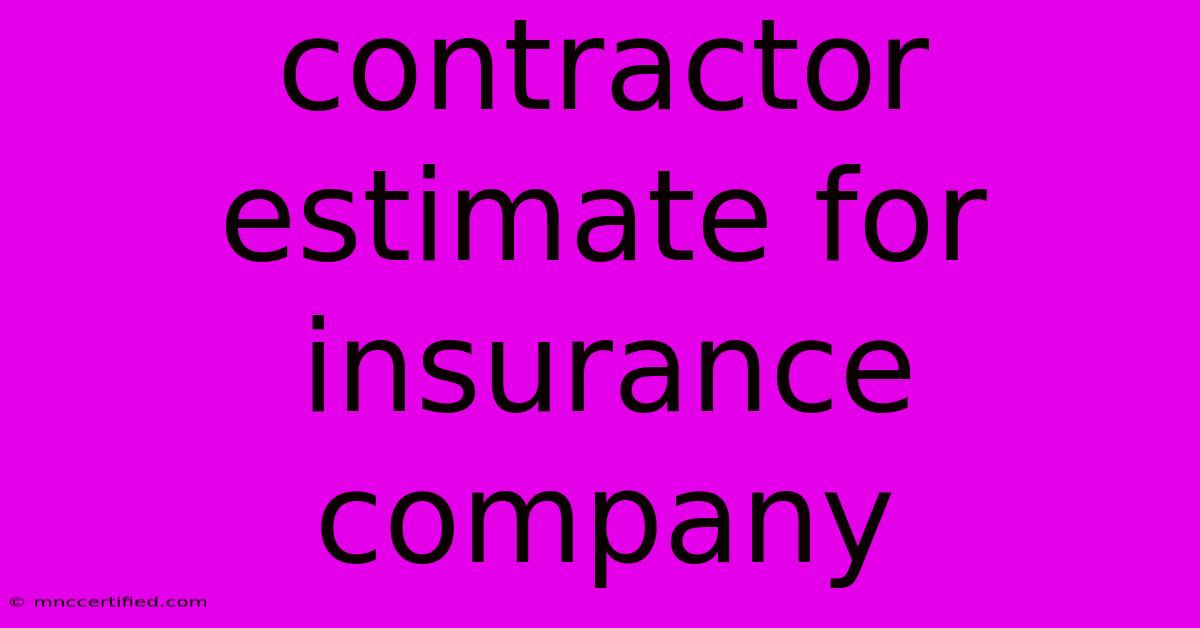Contractor Estimate For Insurance Company

Table of Contents
Contractor Estimates: A Crucial Tool for Insurance Companies
When a disaster strikes, homeowners rely on their insurance companies to help them rebuild their lives. But for insurance companies, the process of assessing damage and determining the cost of repairs can be complex. This is where contractor estimates play a critical role, providing a vital bridge between the insurer and the policyholder.
Understanding Contractor Estimates
A contractor estimate is a detailed document prepared by a qualified contractor outlining the scope of work, materials, labor costs, and overall estimated cost to repair or rebuild a damaged property. These estimates are essential for insurance companies as they:
- Provide accurate cost information: Estimates help insurers determine the actual financial impact of the claim, ensuring fair and accurate compensation for policyholders.
- Streamline the claims process: Having a clear and detailed estimate accelerates the claims process, reducing the time it takes for policyholders to receive their payouts.
- Minimize disputes: A well-prepared estimate reduces the potential for disputes regarding repair costs, leading to a more positive experience for both the policyholder and the insurer.
Types of Contractor Estimates
There are various types of contractor estimates, each serving a specific purpose:
1. Preliminary Estimate: A preliminary estimate is a quick and informal assessment, usually based on limited information and visual inspections. This type is useful for insurance adjusters to get a general idea of the damage and potential repair costs. 2. Detailed Estimate: A detailed estimate offers a comprehensive breakdown of all costs, including labor, materials, permits, and other associated expenses. This type is essential for insurers to evaluate the true scope of the work and ensure sufficient funds are allocated for the repairs. 3. Line-Item Estimate: Line-item estimates break down the repair costs by individual components, such as roofing, plumbing, electrical, and carpentry. This type provides a granular view of the project, making it easier for insurance companies to analyze and approve specific repair items.
Importance of Accurate Contractor Estimates
Accuracy is paramount when it comes to contractor estimates. An inaccurate estimate can result in:
- Underpayment: Policyholders may receive inadequate compensation for their repairs, leading to financial hardship and potential legal issues.
- Overpayment: Insurance companies may overpay for repairs, leading to financial losses and increased premiums for all policyholders.
- Delayed repairs: Inaccurate estimates can slow down the claims process, leaving policyholders in limbo and unable to access the funds they need for reconstruction.
Tips for Insurance Companies to Improve Contractor Estimates
Here are some actionable tips for insurance companies to enhance the accuracy and efficiency of contractor estimates:
- Utilize experienced and reputable contractors: Partner with qualified and experienced contractors who understand insurance claims and can accurately assess damage and provide comprehensive estimates.
- Implement standardized procedures: Establish clear guidelines and procedures for contractors to follow when preparing estimates, ensuring consistency and reducing errors.
- Invest in technology: Use software solutions that streamline the estimate process, enable accurate cost calculations, and facilitate communication between contractors and adjusters.
- Conduct regular audits: Periodically review contractor estimates to identify areas for improvement and ensure compliance with industry standards.
Conclusion
Contractor estimates are an indispensable tool for insurance companies, enabling them to accurately assess damage, determine repair costs, and ensure fair compensation for policyholders. By prioritizing accuracy, transparency, and efficiency in the estimate process, insurance companies can strengthen their relationships with policyholders, optimize their claims handling, and maintain financial stability.

Thank you for visiting our website wich cover about Contractor Estimate For Insurance Company. We hope the information provided has been useful to you. Feel free to contact us if you have any questions or need further assistance. See you next time and dont miss to bookmark.
Featured Posts
-
Fan Support Powers Bayern Victory Over Benfica
Nov 07, 2024
-
How To Get Insurance To Cover A Tummy Tuck
Nov 07, 2024
-
Deciding Match West Indies Bowl Both Sides Adjust
Nov 07, 2024
-
Germania Insurance Amphitheater Best Seats
Nov 07, 2024
-
Is Wind And Hail Insurance Required In Nc
Nov 07, 2024